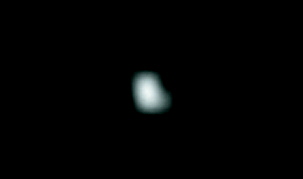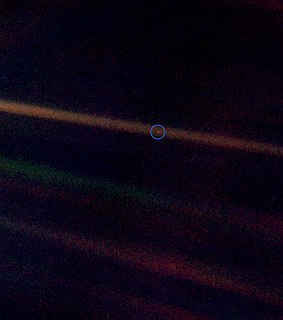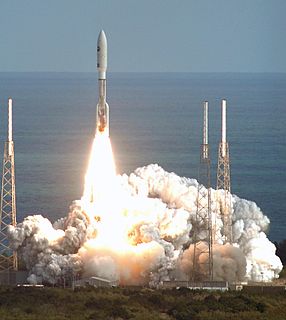Related Research Articles

New Horizons is an interplanetary space probe that was launched as a part of NASA's New Frontiers program. Engineered by the Johns Hopkins University Applied Physics Laboratory (APL) and the Southwest Research Institute (SwRI), with a team led by S. Alan Stern, the spacecraft was launched in 2006 with the primary mission to perform a flyby study of the Pluto system in 2015, and a secondary mission to fly by and study one or more other Kuiper belt objects (KBOs) in the decade to follow, which became a mission to 486958 Arrokoth. It is the fifth space probe to achieve the escape velocity needed to leave the Solar System.

STS-42 was a Space Shuttle Discovery mission with the Spacelab module. Liftoff was originally scheduled for 8:45 EST 22 January 1992, but the launch was delayed due to weather constraints. Discovery successfully lifted off an hour later at 9:52 EST. The main goal of the mission was to study the effects of microgravity on a variety of organisms. The shuttle landed at 8:07 PST on 30 January 1992 on Runway 22, Edwards Air Force Base, California. STS-42 was the first of two flights in 1992 of Discovery, the second of which occurred during STS-53, which launched on 2 December 1992. The mission was also the last mission of the Space Shuttle Discovery to have a seven-member crew until STS-82, which was launched on 11 February 1997.

Atlas V is an expendable launch system and the fifth major version in the Atlas rocket family. It was originally designed by Lockheed Martin, now being operated by United Launch Alliance (ULA), a joint venture between Lockheed Martin and Boeing. Atlas V is also a major NASA launch vehicle.

Sol Alan Stern is an American engineer and planetary scientist. He is the principal investigator of the New Horizons mission to Pluto and the Chief Scientist at Moon Express.
The New Frontiers program is a series of space exploration missions being conducted by NASA with the purpose of furthering the understanding of the Solar System. The program selects medium-class missions which can provide high science returns.

132524 APL, provisional designation 2002 JF56, is a small background asteroid in the intermediate asteroid belt. It was discovered by LINEAR in May 2002, and imaged by the New Horizons space probe on its flyby in June 2006, when it was passing through the asteroid belt. The stony S-type asteroid measures approximately 2.5 kilometers (1.6 miles) in diameter.

Star 48 is a type of solid rocket motor used by many space propulsion and launch vehicle stages. It is used almost exclusively as an upper stage. It was developed primarily by Thiokol Propulsion, and is now, after several mergers, manufactured by Northrop Grumman’s Space Systems division. A Star 48B stage is also one of the few man-made items sent on escape trajectories out of the Solar System, although it is derelict since its use. The Star 48B variant was the PAM-D upper stage used on the now retired Delta II rocket.
The exploration of Jupiter has been conducted via close observations by automated spacecraft. It began with the arrival of Pioneer 10 into the Jovian system in 1973, and, as of 2016, has continued with eight further spacecraft missions. All of these missions were undertaken by the National Aeronautics and Space Administration (NASA), and all but two were flybys taking detailed observations without landing or entering orbit. These probes make Jupiter the most visited of the Solar System's outer planets as all missions to the outer Solar System have used Jupiter flybys. On 5 July 2016, spacecraft Juno arrived and entered the planet's orbit—the second craft ever to do so. Sending a craft to Jupiter is difficult, mostly due to large fuel requirements and the effects of the planet's harsh radiation environment.

A space probe, or simply probe, is a robotic spacecraft that doesn't orbit the Earth, but instead explores farther into outer space. A space probe may approach the Moon; travel through interplanetary space; flyby, orbit, or land or fly on other planetary bodies; or enter interstellar space.

The National Aeronautics and Space Administration is an independent agency of the U.S. federal government responsible for the civilian space program, as well as aeronautics and space research.

Discovery and exploration of the Solar System is observation, visitation, and increase in knowledge and understanding of Earth's "cosmic neighborhood". This includes the Sun, Earth and the Moon, the major planets Mercury, Venus, Mars, Jupiter, Saturn, Uranus, and Neptune, their satellites, as well as smaller bodies including comets, asteroids, and dust.
The Solar System — our Sun's system of planets, moons, and smaller debris — is humankind's cosmic backyard. Small by factors of millions compared to interstellar distances, the spaces between the planets are daunting, but technologically surmountable.

The exploration of Pluto began with the arrival of the New Horizons probe in July 2015, though proposals for such a mission had been studied for many decades. There are no plans as yet for a follow-up mission, though follow-up concepts have been studied.

AJ-60A is a solid rocket booster produced by Aerojet Rocketdyne. Up to 2020 they were used as strap-on boosters on the United Launch Alliance Atlas V rocket.

The Planetary Missions Program Office is a division of NASA headquartered at the Marshall Space Flight Center, formed by the agency's Science Mission Directorate (SMD). Succeeding the Discovery and New Frontiers Program Office, it was established in 2014 to manage the Discovery and New Frontiers programs of low and medium-cost missions by third-party institutions, and the Solar System Exploration program of NASA-led missions that focus on prioritized planetary science objectives. The Discovery and New Frontiers programs were established in 1992 and 2001 respectively, and have launched fourteen primary missions together, along with two missions launched under the administration of the Planetary Missions Program Office. The Solar System Exploration Program was established alongside the office, with three missions planned for launch under the new program.

Ralph is a science instrument aboard the robotic New Horizons spacecraft, which was launched in 2006. Ralph is a visible and infrared imager and spectrometer to provide maps of relevant astronomical targets based on data from that hardware. Ralph has two major subinstruments, LEISA and MVIC. MVIC stands for Multispectral Visible Imaging Camera and is a color imaging device, while LEISA originally stood for Linear Etalon Imaging Spectral Array and is an infrared imaging spectrometer for spaceflight. LEISA observes 250 discrete wavelengths of infrared light from 1.25 to 2.5 micrometers. MVIC is a pushbroom scanner type of design with seven channels, including red, blue, near-infrared (NIR), and methane.

The Venetia Burney Student Dust Counter (VBSDC) is a scientific instrument aboard the unmanned New Horizons space probe that is designed to detect dust impacts in outer space. VBSDC is the first planetary science instrument to be built by students. The dust counter was launched in 2006, and named later that year after Venetia Burney, the young girl who originally named Pluto. The detector works when dust strikes films of polarized polyvinylidene fluoride (PVDF), which generates an electrical charge. The space dust is then detected over the course of the New Horizons spacecraft flight out of the Solar System and past Pluto.

The Science Programme of the European Space Agency is a long-term programme of space science and space exploration missions. Managed by the agency's Directorate of Science, The programme funds the development, launch, and operation of missions led by European space agencies and institutions through generational campaigns. Horizon 2000, the programme's first campaign, facilitated the development of eight missions between 1985 and 1995 including four "cornerstone missions" – SOHO and Cluster II, XMM-Newton, Rosetta, and Herschel. Horizon 2000 Plus, the programme's second campaign, facilitated the development of Gaia, LISA Pathfinder, and BepiColombo between 1995 and 2005. The programme's current campaign since 2005, Cosmic Vision, has so far funded the development of ten missions including three flagship missions, JUICE, ATHENA, and LISA. The programme's upcoming fourth campaign, Voyage 2050, is currently being drafted. Collaboration with agencies and institutions outside of Europe occasionally occur in the Science Programme, including a collaboration with NASA on Cassini–Huygens and the CNSA on SMILE.
References
- 1 2 3 Shuster, Patrick (January 16, 2006). "Spacecraft will carry memory of Sagamore native". Trib Total Media, Inc. Retrieved July 8, 2015.
